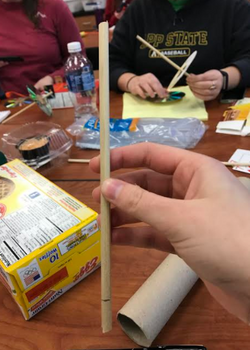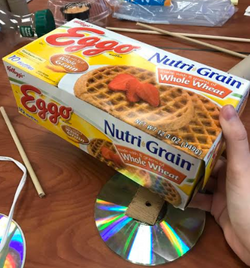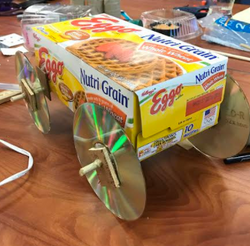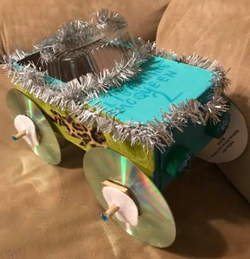
Additional/Optional Materials:
-
Pipe cleaners (or other materials to use as seat belts
-
Hot glue
-
Various art supplies for vehicle decoration
3. Video of our car in action:
4. Data Chart:
5. Graph Showing Ramp Height vs. Average Distance:
6. The Science Behind our Car:
-
Seat belt and Newton's Laws: According to Newton's first law, an object in motion stay in motion and with the same speed and in the same direction unless it is acted upon by an unbalanced force. Just like the vehicle has inertia (in our case, when it is traveling down the ramp and continues along the hallway), the passengers inside of the vehicle do as well (our recreating vermin in this case). If a vehicle stops suddenly and the passenger is not wearing a seat belt, in accordance with Newton's Laws, the passenger will continue in the same direction that they were going in before the car stopped (which is why seat belts are so important!). If the passenger is wearing a seat belt, the seat belt is what acts as an unbalanced force against the passenger, rather than the car's windshield.
-
Energy Transfer: Energy transfer is the process of converting energy from one form to another. In the case of this project, the energy transfer process would look something like this: sun (solar energy --> plants --> food (from animals/plants) --> to me (eating the food) --> to the top of the ramp (gravitational potential energy) --> to when the car is moving (kinetic energy) --> to the energy coming out as sound and heat (friction)
-
Where the energy went: Throughout this process, not energy was lost, it was just turned into something else. In this case, the solar energy that powered our cars (process above) turned in to sound and friction (heat). The idea of "where the energy went" can also be illustrated with Euler's Disk (video below). Compared to a spinning quarter, which spins for about 10 seconds before running out of energy, the Euler's Disk is much heavier, which means that it uses more of my energy to spin it (more breakfast). The heavier weight means that the disk has more gravitational potential energy than something light, like the quarter, and therefore can transfer to more kinetic energy. In the case of Euler's Disk, the kinetic energy is converted into heat (friction between the disk and the mirror) and sound (which you can hear when you watch the video!)
7. Connections to the K-6 Science Curriculum:
1.P.1.3 Predict the effect of a given force on the motion of an object, including balanced forces
3.P.1.1 Infer changes in speed or direction resulting from forces acting on an object
5.P.1.1 Explain how factors such as gravity, friction, and change in mass affect the motion of objects.
5.P.1.3 Illustrate the motion of an object using a graph to show a change in position over a period of time.
Phy.1.2.3 Explain forces using Newton’s laws of motion as well as the universal law of gravitation.
8. Math tools used in this project: averaging, measuring, graphing
I'm a paragraph. Click here to add your own text and edit me. It's easy.
2. Photo Gallery Key (From left to right):
a. Dowel rod (axel)
b. Cardboard square (barring)
c. 23 x 12 x 8 cm box (chasis)
d. Wheel with wheel adapter (CD with luan plywood 1/8")
e. Box (chasis) with barrings (cardboard) attached
f. Wheel (CD) and wheel adapter (plywood) attached to dowel rod (axel)
g. Assembled vehicle
h. Completed and decorated vehicle
 Dowel Rod (axel) |  Barring (cardboard) |  Waffle box (chasis) |
|---|---|---|
 Wheel (CD) with wheel adapter |  Chasis with barrings |  Wheel attached to axel |
 Assembled vehicle |  Decorated vehicle |
1. Our vehicle's name: Lightning McQueen 2



Regina Vermina Radicial Velocity Rolling Vehicle for Recreating Vermin
This week, we created vehicles that carry gummy worms! This project introduced our class to solar energy transfer (it turns out that our vehicles are, in fact, solar powered!), Newton's First Law (objects in motion tend to stay in motion!) and answered the question: where did the energy go?

